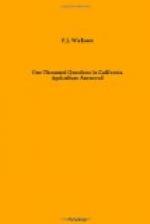Cheesecloth, not heavy cloth, would be better than glass, so far as the sun is concerned. There would be none of the overheating during the middle of the day followed by the chilling at night which are caused by a large expanse of glass. On the other hand, there should not be openings on opposite sides of the house to create a draft. Also, the rat and vermin question must be considered. It might be necessary to have wire screens made to fit firmly over the cloth at night.
Grains for Chickens.
What variety of grain adopted for poultry food will be the best to grow, with and also without irrigation?
Wheat is a standard grain for poultry feeding, and Egyptian corn is also largely used. Indian corn is also satisfactory, under the general roles for compounding poultry rations which are laid down by all authorities on the subject. Egyptian corn is very successful in the interior parts of the State, and, on lands which are winter-plowed and harrow to retain moisture, very satisfactory results can be secured by summer growth without irrigation from planting as soon as frost danger is over.
Plucking Ducks and Geese.
I would like to know about how, when and how often to pick old ducks so as to get the feathers for pillows and not kill the ducks, either. Will they lay any eggs while growing new feathers?
Neither ducks nor geese should be plucked until after the laying season is over, which will be in July. Just before the moult, when the feathers begin to loosen, they may be plucked again. Those most considerate of their birds make only this latter plucking, which does not greatly inconvenience the fowls. At no time must they be plucked unless the feathers are “ripe”; that is, dry at the root, so that no bleeding or injury to the skin is caused. An old stocking is drawn over the head of the victim, and the bird held in the plucker’s lap on a burlap apron; then the soft feathers on the body are quickly and very gently removed; but those on the side of the body which support the wings should not be taken. Great care should be exercised not to injure the skin or pinfeathers or pull the down. To grow new feathers quickly and resume laying are matters which depend largely upon the condition of the bird and the feed. The latter should consist of some 15 per cent of animal food.
Feeding Hens for Hatching Eggs.
Should soft feed be given to the mothers of chicks intended for broilers? How about dry mash? How would you advise feeding animal protein?
Cut out all ground feed, except perhaps a little wheat bran. While you may not get quite as many eggs, they will all have good strong germs and the chicks will stand forcing to the limit, while if you force the egg output you reduce the vitality of the germs and livability of chicks hatched. The only way to feed hens whose eggs are intended for hatching chicks for broilers is to feed whole grain and make




